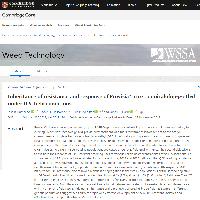Resumen
- Provisia™ rice was developed recently by the BASF Corporation for control of grass weeds and is complementary to existing Clearfield ® technology. Our previous research showed that resistance of Provisia™ rice to the ACCase herbicide quizalofop-p-ethyl (QPE) in laboratory and greenhouse environments is governed by a single dominant Mendelian gene. However, these results may not be consistent in different populations or field environments. Therefore, the first objective of the current research is to determine the inheritance of resistance to QPE in rice using different segregating populations evaluated under U.S. field environments. The second objective is to evaluate response of QPE resistant breeding lines to various herbicide concentrations at two U.S. (Louisiana) locations. Chi-square tests of 12 F 2 populations evaluated in Louisiana environments during 2014 and 2015 indicated that QPE seedling resistance at 240 g ai ha ⁻¹ was governed by a single dominant Mendelian gene with no observable maternal effects. Similar results were obtained in 5 F 3 populations derived from the aforementioned F 2 populations. Allele-specific SNP markers for QPE resistance also followed Mendelian segregation in the five F 2 populations. For the second objective, six QPE resistant inbred lines showed transient leaf injury at 1X (120 g ai ha ⁻¹ ) or 2X (240 g ai ha ⁻¹ ) field rates, 7 and 21 d after treatment (DAT). However, a trend of reduced injury (recovery) from 7 through 33 DAT was observed for all breeding material. No differences in grain yield were found between untreated QPE resistant lines and those treated with 1X or 2X QPE field rate. Single gene inheritance and good levels of QPE herbicide field resistance in different genetic populations suggest feasibility for rapid and effective development of new QPE resistant varieties and effective stewardship of the Provisia™ technology.
